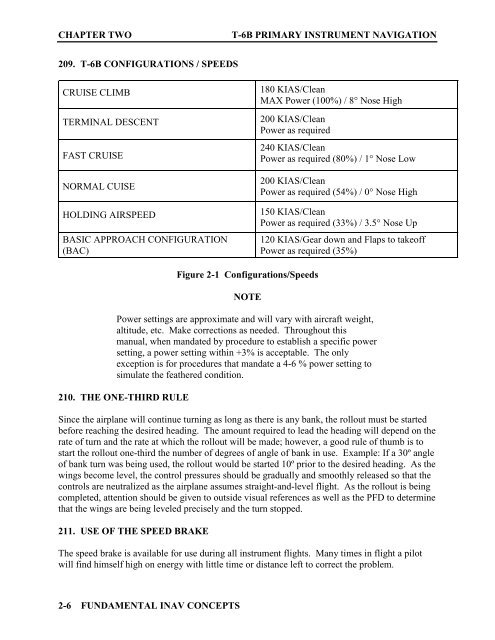Flight Training Instruction - Cnatra - U.S. Navy
Flight Training Instruction - Cnatra - U.S. Navy
Flight Training Instruction - Cnatra - U.S. Navy
You also want an ePaper? Increase the reach of your titles
YUMPU automatically turns print PDFs into web optimized ePapers that Google loves.
CHAPTER TWO T-6B PRIMARY INSTRUMENT NAVIGATION<br />
209. T-6B CONFIGURATIONS / SPEEDS<br />
CRUISE CLIMB<br />
TERMINAL DESCENT<br />
FAST CRUISE<br />
NORMAL CUISE<br />
HOLDING AIRSPEED<br />
BASIC APPROACH CONFIGURATION<br />
(BAC)<br />
2-6 FUNDAMENTAL INAV CONCEPTS<br />
180 KIAS/Clean<br />
MAX Power (100%) / 8° Nose High<br />
200 KIAS/Clean<br />
Power as required<br />
Figure 2-1 Configurations/Speeds<br />
NOTE<br />
240 KIAS/Clean<br />
Power as required (80%) / 1° Nose Low<br />
200 KIAS/Clean<br />
Power as required (54%) / 0° Nose High<br />
150 KIAS/Clean<br />
Power as required (33%) / 3.5° Nose Up<br />
120 KIAS/Gear down and Flaps to takeoff<br />
Power as required (35%)<br />
Power settings are approximate and will vary with aircraft weight,<br />
altitude, etc. Make corrections as needed. Throughout this<br />
manual, when mandated by procedure to establish a specific power<br />
setting, a power setting within +3% is acceptable. The only<br />
exception is for procedures that mandate a 4-6 % power setting to<br />
simulate the feathered condition.<br />
210. THE ONE-THIRD RULE<br />
Since the airplane will continue turning as long as there is any bank, the rollout must be started<br />
before reaching the desired heading. The amount required to lead the heading will depend on the<br />
rate of turn and the rate at which the rollout will be made; however, a good rule of thumb is to<br />
start the rollout one-third the number of degrees of angle of bank in use. Example: If a 30º angle<br />
of bank turn was being used, the rollout would be started 10º prior to the desired heading. As the<br />
wings become level, the control pressures should be gradually and smoothly released so that the<br />
controls are neutralized as the airplane assumes straight-and-level flight. As the rollout is being<br />
completed, attention should be given to outside visual references as well as the PFD to determine<br />
that the wings are being leveled precisely and the turn stopped.<br />
211. USE OF THE SPEED BRAKE<br />
The speed brake is available for use during all instrument flights. Many times in flight a pilot<br />
will find himself high on energy with little time or distance left to correct the problem.
















